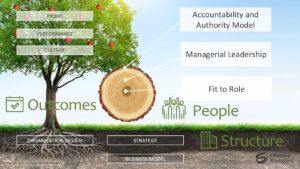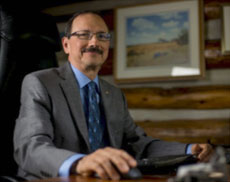The question every CEO eventually asks
“How can I make sure my organization keeps growing – even through tough times?”
Every CEO knows that success isn’t about what happens in one quarter or one year. It’s about creating the conditions for the organization to thrive long term, no matter how turbulent the environment becomes.
That’s where the Tree Model comes in. It’s a simple yet powerful way to visualize how an organization grows – and what makes it resilient.
Just as a tree relies on its structure below the ground, its visible outcomes above the ground, and the trunk that connects them, a successful organization depends on the same three forces working in harmony: structure, outcomes, and people.
Structure: The Foundation Beneath the Surface
A tree’s real strength begins where no one can see it. Its health depends on the integrity of what lies underground – the bedrock, the
In the same way, an organization’s success starts with its structure: the fundamental design that determines how well everything else can grow.
The Bedrock: The Business Model
Bedrock provides stability. It anchors the tree in place and keeps it from washing away.
In organizations, the business model plays this role – defining how the organization creates, delivers, and captures value.
If this foundation isn’t clear or consistent, the entire enterprise wobbles. CEOs must ensure the business model is solid and aligned with purpose.
The Topsoil: Strategy
Topsoil gives life. It provides the nutrients that allow growth and regeneration.
For organizations, strategy is that topsoil – constantly renewed, responsive to change, and essential for feeding growth.
A great business model without strategy is like fertile soil left fallow. Strategy channels energy toward the outcomes the organization seeks to achieve.
The Roots: Organization Design
Roots connect everything. They absorb nutrients, anchor the tree, and define its reach.
In the organization, organization design plays the same role. It aligns roles, layers, and accountabilities so work can flow efficiently and decisions can be made at the right level.
If roots are too shallow, the tree may grow quickly but won’t survive strong winds. If organization design doesn’t match the complexity of the work, the same thing happens – short-term results but long-term fragility.
- Outcomes: The Visible Evidence of Success
Above ground, we see the results – the branches, the leaves, and the fruit.
In an organization, these represent outcomes: culture, performance, and results.
They’re what everyone notices first, but they’re not where growth begins. They’re the visible signs of whether the foundation is strong and the system underneath is working.
The Branches: Culture
The branches shape the tree’s form. They tell you how it has responded to sunlight, weather, and time.
In the organization, culture serves the same purpose. It shows how people behave, make decisions, and work together in real life.
But culture isn’t a lever you can pull – it’s an outcome. It grows naturally from how structure and people interact.
If you want to change culture, you don’t prune the branches; you change what’s happening at the roots.
The Foliage: Performance Metrics
The leaves are where energy is created – through photosynthesis, the tree turns light into growth.
In an organization, these are your performance metrics: the daily indicators of health, productivity, and alignment.
Bright green foliage means the system is thriving; yellowing leaves mean stress.
When performance starts to fade, it’s a sign that something below the surface – in structure or leadership – needs attention.
The Fruit: Results
The fruit is what we harvest – the purpose of all that growth.
For a business, it’s profit. For a non-profit, it’s service impact. For a public institution, it’s the outcomes achieved for citizens.
Healthy fruit comes from a healthy tree. You can’t paint fruit red and call it ripe.
Real, sustainable results only appear when structure and people are in balance, feeding outcomes naturally over time.
- People: The Trunk That Ties It All Together
Between the hidden structure and the visible outcomes stands the trunk – the living connection that holds it all together.
In an organization, this represents people – the leaders and managers whose work connects design to delivery.
The trunk has three essential elements: accountability and authority, managerial leadership, and fit to role.
The Bark: Accountability and Authority
The bark protects the tree, maintaining its shape and integrity. It defines boundaries and keeps the system safe.
In organizations, this is the accountability and authority framework – the system that clarifies who is accountable for what, and what authority they have to act.
When accountability and authority are aligned, work flows smoothly. When they’re mismatched, the bark cracks – confusion spreads, and performance suffers.
The Wood: Managerial Leadership
The wood inside gives the tree strength and flexibility. It allows growth, but keeps the structure upright.
This is the role of managerial leadership – ensuring managers plan effectively, delegate clearly, set context, coach their teams, and provide feedback.
Managerial leadership transforms good intentions into action. It’s the strength that allows the organization to grow taller, supporting more branches and bearing more fruit without breaking.
The Core: Fit to Role
At the very center lies the heartwood – the dense, living core that keeps the tree alive and stable.
This represents fit to role: having the right person, with the right capability and problem-solving capacity, in the right position.
When fit to role is right, the whole trunk functions as a living, breathing conduit between strategy and results. When it’s wrong, everything else starts to decay from within.
The Real Lesson of the Tree
When organizations struggle, most CEOs start pruning – they change people, tweak incentives, or chase new outcomes.
But the most resilient leaders know that problems at the top usually start below the surface.
To grow a resilient organization, focus first on the structure, then ensure your outcomes reflect health, and finally, strengthen the people system that connects the two.
A great CEO doesn’t just grow a bigger tree. They grow a stronger one – rooted deeply, balanced perfectly, and ready for any season.
Learn More
This article draws on The Effective CEO: The Balancing Act that Drives Sustainable Performance. Get your copy on Amazon to explore the full Tree Model and learn how CEOs can cultivate organizations that stand tall, year after year.







